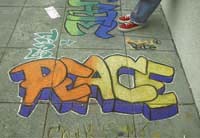Alternative news sources report that a Department of Peace (DoP) is in the works, but the mass media seems to have missed out on this groundbreaking proposal. When a CNN reporter recently announced the idea, the patronizing tone of her voice betrayed her skepticism, and she did not seriously explore the substance of the proposal when she interviewed a guest about it. In a venture to take the next step, I’ve investigated what a DoP means for our society and why it is necessary.¹
Dennis Kucinich, a congressional representative from Ohio, has drawn this legislation from the dusty shelves of American history and it echoes a voice that dates as far back as the George Washington Administration in 1783. In line with their revolutionary pursuits the architect and publisher Benjamin Banneker teamed with the physician and educator Dr. Benjamin Rush to propose a “peace office” which would serve on the same level as the “war office” in 1792.²
Today, both major parties’ rhetoric espouses that democratic countries are less likely to go to war with one another. This “Democratic Peace Theory” is one of the foundations of U.S. foreign policy. According to President Bush:
“The reason why I’m so strong on democracy is democracies don’t go to war with each other. And the reason why is the people of most societies don’t like war, and they understand what war means.... I’ve got great faith in democracies to promote peace. And that’s why I’m such a strong believer that the way forward in the Middle East, the broader Middle East, is to promote democracy.”³
However, the logic of using war to eradicate war doesn’t seem to work in practice or in theory. From Korea to Iraq, war has shattered lives without creating the conditions for peace and rebuilding. How are we to eradicate war by using it as a strategy? It would seem wiser to call in peace specialists to provide a creative and new approach to the promotion of peace, rather than rely on war specialists. In the words of Representative Kucinich, “It is time to jettison our illusions and fears and to transform age-old challenges with new thinking. This is the idea behind my proposal to establish a DoP.” Marianne Williamson, an author, activist, and founder of the Peace Alliance, the grassroots campaign supporting the DoP legislation, sees this as important as the struggles for women’s suffrage and the abolition of slavery.
The contemporary effort towards peace faces two challenges that a DoP would help to overcome. First, the DoP (DoP) would address the misconception that peace is only an end. The Department would demonstrate that peace is also a means to achieve the goal. In the words of AJ Muste: “There is no way to Peace, Peace is the way.” The second roadblock is that the amount of material and energy put into peace theory is just a fraction of that poured into militarism and strategic use of violence. A DoP would create an institutional grounding for more research into peace theory, which provides nonviolent means of solving both domestic and international problems.
In a study of power, leading peace theorist Kenneth Boulding describes three kinds: threat, exchange, and integrative power. Threat power says “Do something I want or I’ll do something you don’t want,” whereas exchange power says, “give me something I want and I’ll give you something you want.” Integrative power, the least understood, says, “I will do something from my heart and have faith that we’ll grow closer in the process”. Integrative power leads to greater integration of the parties involved. Integrative Power is studied by peace studies programs throughout the country and has been used by Gandhi in South Africa and India, Dr. Martin Luther King, Jr. in the Civil Rights Movement and Aung San Suu Kyi, the leader of a nonviolent struggle for human rights and democracy in Burma. 4
The DoP proposes to explore the uses of Integrative Power on an institutional level. The Department will facilitate the study and application of peace theory and practices, and will create a government-sponsored Peace Academy. The Peace Academy would be modeled after the military services academies, providing a four-year training program that requires graduates to serve for five years in programs dedicated to domestic or international nonviolent conflict resolution. Such a commitment represents proactive community building by well-trained nonviolence practitioners in order to build up nonviolence within our society as a preventative measure.
The DoP overlaps with the missions of many existing government programs. However, the DoP would introduce vastly different ways of dealing with many existing problems. For example, the current justice system, based on “retributive justice,” dehumanizes the perpetrator and uses a punishment-based approach--prison or capital punishment--that in the long run doesn’t work to reduce crime or protect society. The DoP would begin to implement a new model called restorative justice, which focuses on rehabilitating and reintroducing delinquents back into their communities, creating healing for both the offender and the victim, and preserving the sense of humanity and respect for life.
The DoP proposal attempts to achieve the stated goal of the US Department of Defense, which is to “deter war and protect the security of our country.” When Kucinich was questioned about the practicality of a DoP he responded: “What could have been more impractical than a war that did not have to be fought. That’s taken over 2000 lives of American soldiers. That’s taken over 16,000 American casualties . . .Peace is practical. War is NOT.” The war paradigm is breaking down. The best prescription for humanity’s challenges is a force with changing and unimagined tactics.
The Peace Alliance: www.thepeacealliance.org
Americans for Department of Peace:
http://www.afdop.org/
PEACEPOD podcasting provides daily updates, news, and information for the Department of Peace movement and more.
http://www.songserverworldwide.com/music-group-5.html
¹CNN coverage can be viewed online at:
http://www.thepeacealliance.org/content/view/12/67/
²Ain’t gonna study war no more”, Milton Meltzer. Random House Books, July 2002
³“President and Prime Minister Blair discussed Iraq, Middle East”
http://www.whitehouse.gov/news/releases/2004/11/20041112-5.html
4 Boulding, Kenneth E. Three Faces of Power. (Sage, 1989)
5 http://www.kucinich.us/issues/departmentpeace.php



